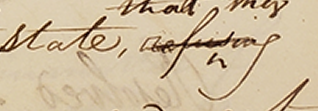Examining this section closely, there is indeed reason to suspect that the area around the word “refuse” was altered after the original writing:

Ink and Pen Flow:
The ink used for refuse appears slightly darker and denser than the adjacent
writing, especially compared to state and ing. This often occurs when
a correction or insertion is made later using a pen refilled with fresh
ink or a different quill.
Letter Formation Differences:
The r and f in refuse are noticeably heavier and less fluid than the more
consistent cursive elsewhere on the document. The writer’s hand seems
to have slowed, suggesting deliberate overwriting rather than continuous
motion.
Spatial Anomaly:
There’s a small but visible gap between refuse and ing, unlike the
natural ligatures seen in the rest of the text. This separation may indicate
that ing was part of the original word (perhaps agreeing or adopting),
and the preceding letters were removed or overwritten.
Surface Disturbance:
Around the r and e, faint lighter areas and irregular fiber texture suggest
possible mechanical abrasion or chemical alteration—typical signs
of erasure on rag paper. Under magnification, these would appear as slightly
glossy or thinned spots.
Alignment Irregularity:
The baseline of refuse dips slightly below that of the surrounding text,
indicating that it was written after some scraping or rubbing, when the
surface lost its evenness.
Forensic Conclusion (non-legal opinion)
There is moderate visual evidence that the word “refuse” was
written over a previously erased or removed word, likely one of similar
length and ending with ing. The separation and ink variation suggest that
refuse was substituted later, while ing from the original term was left
intact.